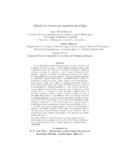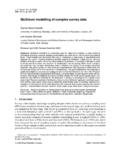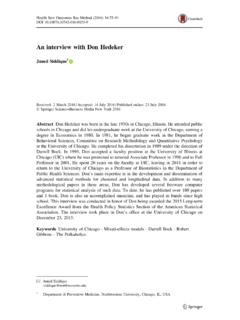Transcription of Multilevel modelling of ordered and unordered categorical ...
1 Slide1'&$%Multilevelmodellingof orderedandunorderedcategoricalresponsesS ophiaRabe-HeskethInstituteof PsychiatryKing'sCollegeLondonJointwork withAndersSkrondal,NorwegianInstituteof PublicHealth,OsloandAndrewPickles,TheUni versity of ManchesterInstituteof ChildHealthLondon,February 2003 Slide2'&$%Outline Orderedcategoricalresponses{Single-level models{Multilevelmodels Two-levelrandominterceptmodels Cluster-speci candpopulationaveragee ects Multilevelrandomcoe cientmodels{Estimationmethods{Analysisof clusterrandomizedtrialof sexeducation Unorderedcategoricalresponses{Single-lev elmodels{Multilevelmodels{Analysisof abuseof antibioticsin youngchildrenin China1 Slide3'&$%I. Orderedcategoricalresponses Onlya smallnumber of responsesor `categories'are possible,ys,s= 1; ; S Thecategoriesare ordered ,y1< y2< < yS;we0ll setys=s Examples:{Severity of symptoms( ):`none',`moderate',`severe'{Frequencyof symptoms:`never',`occasionally',`nearlye veryday',`everyday'{Responseto treatment:`progressivedisease',`nochange ',`partialremission',`completeremission' {Diagnosis:`non-autistic',`PDD-NOS'(perv asivedevelopmentdisorder),`autistic'{Tes tresults( ):`normal',`borderline',`abnormal'{Satis factionwithtreatment:`verydissatis ed',`dissatis ed',`satis ed',`verysatis ed'Slide4'&$%Latentresponsemodels Underlyingtheobservedordinalresponseyifo r subjectiis alatent(unobserved)continousresponsey i.}}}}}}}}}}}}}
2 A thresholdmodeldeterminestheobservedrespo nse:yi=8>>>>>>>>>>> <>>>>>>>>>>>:1ify i 12if 1<y i S 1<y i; For a probitmodel,y i N(0;1), withS= 3categories:latent k1 k2Pr(y=y1)Pr(y=y2)Pr(y=y3) Thelatentresponseis modelledas a linear regressionwithoutan intercept(for identi cation)y i= 1x1i+ 2x2i+ + i= 0xi+ i2 Slide5'&$%Generalizedlinear models Thecumulativeprobabilitiesare modeledasPr(yi> s) =F( 0xi s); s= 1; ; S 1; theinverselinkfunction Proportionaloddsmodel(logitlink):Pr(yi> s) =exp( 0xi s)1 + exp( 0xi s)log24Pr(yi> s)1 Pr(yi> s)35= 0xi s{Theexponentiatedregressioncoe cientscanbe interpretedas oddsratiosfor highversuslow scoresregardlessofcut-point(proportional odds):Pr(yi> s)=[1 Pr(yi> s)]Pr(yj> s)=[1 Pr(yj> s)]= exp( 0fxi xjg) Cumulativemodelsare equivalentto latentresponsemodels:ModelLinkF 1 Distributionof iVarianceof iProportionaloddslogitlogistic 2=3 Ordinalprobitprobitstandard 2=6 Slide6'&$%Two-levelrandominterceptmodels Subjectsinestedin clustersj( ).}
3 Includearandominterceptujfor clustersin thelatentresponsemodely ij= 0xij+uj+ ij; uj N(0; 2); ujindep:of ij: Thetotalresidual ij=uj+ ijhasvariancevar( ij) =8>> <>>: 2+ 1forprobitmodels 2+ 2=3 forlogitmodels Thecovariancebetweenthetotalresiduals ijand i0jof twosubjectsin thesameclusteris 2andtheintraclasscorrelationis Cor( ij; i0j) =8>> <>>: 2=( 2+ 1)forprobitmodels 2=( 2+ 2=3)forlogitmodels Thelatentresponsesfor two unitsin thesameclusterareconditionallyindependen tgiventherandomintercept:Cor(y ij; y i0jjxij; uj) = 0If we donotconditionontherandomintercept,theco rrelationis theintraclasscorrelationCor(y ij; y i0jjxij) = 3 Slide7'&$%Cluster-speci cversuspopulationaveragee ects For a probitmodel,the`marginal'or populationaverageresponseprobabilitiesar ePr(yij> s) =Pr(y i> s) = Pr( 0xij+ ij> s)=Pr( ij 0xij s)=Pr0@ ijp 2+ 1 0xij sp 2+ 11A= 0@ 0xij sp 2+ 11A;where ij=uj+ ij.{Therefore,themarginale ectsofxijare =p 2+ 1.}
4 Toachievea givenmarginale ect, mustincreaseif 2increases. The`conditional'probabilitiesfor a givenclusterjarePr(yij> sjuj) = 0@ 0xij+uj s11A:{Therefore,theconditionalor cluster-speci ce ects ofxijare greaterthanthemarginalor populationaveragee ects =p 2+ '&$%Cluster-speci cversuspopulationaveragee ectscluster-speci c, '&$%Multilevelrandomcoe cientmodels Considerclusteredlongitudinaldatawithocc asionsi(level1)nestedin subjectsj(level2) in hospitalsk(level3) Exampleof a three-levelrandomcoe cientmodel:y ijk= [u(2)0jk+u(3)0k] + [ 1+u(2)1jk+u(3)1k]x1ijk+ 2x2ijk+ ijk{u(2)0jkandu(3)0kare randominterceptsat levels2 and3.{u(2)1jkandu(3)1kare randomcoe cientsofx1ijk.{Therandomcoe cientshavezeromeansandthe xede ect 1ofx1ijkrepresentsthemeane ect.{Randome ectsat thesamelevelare correlated,(u(2)0jk; u(2)1jk)is bivariatenormal. Generalthree-levelrandomcoe cientmodely ijk= 0xijk+u(2)0jkz(2)ijk+u(3)0jkz(3)ijk+ ijkSlide10'&$%Estimation Estimationof multilevelmodelswithcategoricalresponses ,alsoknownas generalisedlinear mixedmodels(GLMMs),isnoteasybecausetheli kelihood does notgenerallyhaveaclosedform.}}}}}
5 MarginalQuasilikelihood (MQL)andPenalizedQuasilikelihood(PQL)are approximatemethods avaiblableinMLwiNandHLM.{Two versionsare available, rstandsecondorder(MQL-1,MQL-2,PQL-1,PQL- 2),thelastbeingthebest.{EvenPQL-2sometim esproducesbiasedestimates,particularlywh entheclustersare small.{Themethods donotprovidea likelihood. Maximumlikelihood estimationrequiresevaluationof integralssincethelikelihood is marginalwithrespectto therandome ects.{NumericalintegrationusingGauss-Her mitequadratureisusedinMIXOR/MIXNO(two-le velonly),aML,SAS PROCNLMIXED(two-levelonly)andgllamm.{Ada ptivequadratureis superior to `ordinary quadrature'whichsometimesdoesn'twork ( ,counts).Thisis availableinSAS PROCNLMIXED(two-levelonly)andgllamm.{HLM providesa '&$%Clusterrandomizedtrialof sexeducation Schoolswererandomisedto receivesexeducationor not Assessmentspre randomisation,6 monthsand18 monthspostrandomisation Oneoutcomeis a questionrelatingto `Contraceptiveself-e cacy':{\IfmypartnerandI wereaboutto haveintercoursewithouteitherof us havingmentionedcontraception,it wouldbeeasyfor meto producea condom(if I broughtone)"{Thequestionsis answeredin termsof veordinalcategories:`notat all trueof me',`slightlytrueof me',`somewhattrueof me',`mostlytrueof me',`completelytrueof me'.}}}}}}}}
6 Thedataare multilevelwithresponses(level1) from1184pupils(level2) from46 schools(level3). Only570pupilsalways responded, '&$%Models Occasionst, subjectsj, schoolsk Covariates{x1t[Time](0,1, 3){x2jk[Treat](yes=1,no=0){x3tjk[Treat] [Time] Modeltheprobability of exceedinga categorys,s= 1;2;3;4logit[Pr(ytijk> s)] = 1x1t+ 2x2jk+ 3x3tjk+u(2)jk+u(3)k s Estimationusingadaptivequadratureingllam m:gllammuse treattimetreat_time,i(idschool)/**/ link(ologit)family(binom)adapt Conditionalandmarginalprobabilities:gen u1 = 0gen u2 = 0gllapredp_cond,mu us(u)above(2)gllapredp_marg,mu margabove(2)6 Slide13'&$%EstimatesSingle-levelmodelTwo -levelmodelThree-levelmodelParameterEst( SE)Est(SE)Est(SE) 1[Time] ( ) ( ) ( ) 2[Treat] ( ) ( ) ( ) 3[Time] [Treat] ( ) ( ) ( )var(u(2)jk){ ( ) ( )var(u(2)k){{ ( ) ( ) ( ) ( ) ( ) ( ) ( ) ( ) ( ) ( ) ( ) ( ) ( )Log-likelihood-2531-2471-2471 Slide14'&$%Conditionalrelationships Probability of respondingat least`mostlytrueof me'(category3) Relationshipbetweentheprobability andoccasionfor thetwotreatmentgroups,whentherandominter ceptis -1,0 and1.}}}}}}
7 Interventiongroup,controlgroupTime in monthsAt least mostly '&$%Observedandpredictedmarginalproporti onsinterventiongroup,controlgroup, predicted, observedPr(y >1)Pr(y >2)Time in monthsAt least slightly in monthsAt least somewhat (y >3)Pr(y >4)Time in monthsAt least mostly in monthsCompletely '&$%II. Unorderedcategoricalresponses Onlya smallnumber of responsesor `categories'are possible,a,a= 1; ; A. Thecategoriescannotbe ordereda priori. Examples:{Treatmentdecision:`chemotherap y',`surgery',`none'{Healthinsurancechoic e:`NHS',`PPP',etc.{Method of birthcontrol:`pill',`condom',etc.{Diagno sis:`meningitis',`in uenza',`commoncold' Unorderedcategoricalresponsesoftencorres pondto a ` rstchoice'amonga setof '&$%RandomUtility Models Unobserved`utility'Uaiassociatedwitheach alternativea= 1; :::; Afor uniti= 1; :::; N Randomutility modelscomposedasUai=Vai+ ai{Vaiis thelinear predictor{ aiis a residualterm(independentoverianda) Alternativefis chosenifUfi> Ugiforallg6=f aiindependentGumbel distributedmPr(fi) =exp(Vfi)PAa=1exp(Vai)[Conventionalmulti nomiallogit]Slide18'&$%Covariatee ectsontheutilitiesLinear predictor for unitiandalternativea:Vai=ma+ga0xi+b0xai Covariatesandparameters:{maalternativesp eci cconstants{ xivariesoversubjects(butnotalternatives) andhas xede ectsgavaryingoveralternativesExamples:Ag eof subject{ xaivariesoveralternatives(andpossiblysub jects)andhas xede ectsbnotvaryingoveralternativesExample:C ostof treatment(coulddi erbetweencountries) Identi cation:{Probability of choosingalternative1 amongalternatives1, 2and3 canbe expressedin termsof utility di erencesPr(U1 U2>0 andU1 U3>0){Therefore thelocationofVaiis arbitrary:exp(V1i)Paexp(Vai)=exp(V1i+ci) Paexp(Vai+ci){Solution.}}}}}}}}}}}}
8 LastalternativeSservesas referencealternative,setmS= 0andgS= '&$%Multilevelmodels Considerthree-leveldatawithpatientsi(lev el1) treatedbydoctorsj(level2) workingin hospitalsk(level3). We canincluderandome ectsin thelinear predictor:Vaijk=ma+ a(2)0jk+ a(3)0j+[ga0+ a(2)0jk+ a(3)0k]xijk+[b0+ (2)0jk+ (3)0k]xaijk Randomintercepts: a(2)0jkand a(3)0k RandomCoe cientsI: a(2)jkand a(3)kare alternativespeci crandomcoe cientsforsubject-speci ccovariatesxijk. RandomCoe cientsII: (2)jkand (3)kare randomcoe cientsforalternative-speci '&$%Useandabuseof antibioticsfor API Acuterespiritory tractinfection(API)canleadto pneumoniaanddeathif notproperlytreated,butinappropriatefrequ entuseof antibioticscanleadto drugresistance. In the1990'stheWHOintroduceda programof casemanagementfor childrenunder5 in China. Doctor'santibioticprescriptionwas ratedas `abuse'if therewerenoclinicalindicators:1. Abuseof serveralantibiotics2.
9 Abuseof oneantibiotic3. Correctuseof antibiotics(reference-category) Dataare multilevelwith2565childreni(level1) treatedby134doctorsj(level2) in 36 hospitalsk(level3). Covariates(xijk) include{[Age]Agein years (0-5){[Temp]Body temperature,centeredat 36oC{[Paymed]Pay for medication(yes=1,no=0){[Selfmed]Selfmedi cation(yes=1,no=0){[Wrdiag]Wrongdiagnosi s(yes=1,no=0){[WHO]Hospitalin WHOprogram(yes=1,no=0){[DRed]Doctor'sedu cation(self-taughtto ) Thanksto MinYangfor providingthedata10 Slide21'&$%Models Childrenitreatedby doctorsjworkingin hospitalsk Thereare noalternative-speci ccovariatesVaijk=ma+ a(2)jk+ a(3)j+ga0xijk Data:doc childalt choice1 1101 1211 1301 2101 2201 231 Estimationingllammgen categ1= alt == 1gen categ2= alt == 2eq c1: categ1eq c2: categ2gllammalt age , i(dochosp)/**/ nrf(22) eqs(c1c2 c1 c2)/**/ link(mlogit)family(binom)/**/ expanded(childchoicem) basecat(3)Slide22'&$%EstimatesAbusesever alAbuseoneParameterEst(SE)Est(SE)ga0[Con s] ( ) ( )ga1[Age] ( ) ( )ga2[Temp] ( ) ( )ga3[Paymed] ( ) ( )ga4[Selfmed] ( ) ( )ga5[Wrdiag] ( ) ( )ga6[WHO]{{ga7[DRed]{{Doctor-levelvarian cesvar( a(2)0) ( ) ( )Cov( 1(2)0; 2(2)0) ( )Hospital-levelvariancesvar( a(3)0) ( ) ( )Cov( 1(3)0; 2(3)0) ( ) '&$%More EstimatesAbuseseveralAbuseoneParameterEs t(SE)Est(SE)ga0[Cons] ( ) ( )ga1[Age] ( ) ( )ga2[Temp] ( ) ( )ga3[Paymed] ( ) ( )ga4[Selfmed] ( ) ( )ga5[Wrdiag] ( ) ( )ga6[WHO] ( ) ( )ga7[DRed] ( ) ( )Doctor-levelvariancesvar( a(2)0) ( ) ( )Cov( 1(2)0; 2(2)0) ( )Hospital-levelvariancesvar( a(3)0) ( ) ( )Cov( 1(3)0; 2(3)0) ( ) '&$%References \Multilevellogisticregressionfor polytomousdataandrankings".}}}}}}}}}}}
10 Psychometrika, in press.( ) \Generalisedmultilevelstructuralequation modeling".Psychometrika, in press.( , ) Generalized latentvariablemodeling: Multilevel ,longit udinalandstructural equationmodels. Boca Raton,FL:Chapman& Hall/CRC,to appear. ( ). GLLAMMM anual. London:Instituteof Psychiatry, 2001.( , ). \Reliableestimationof generalizedlinear mixedmodelsusingadaptivequadrature".TheS tataJournal, 2: 1-21,2002.( , ).12






